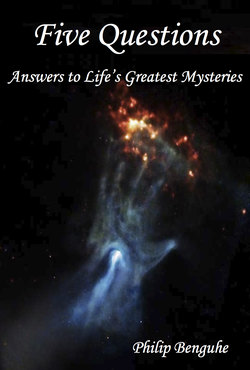Five Questions: Answers to Life's Greatest Mysteries

Реклама. ООО «ЛитРес», ИНН: 7719571260.
Оглавление
Philip Benguhe. Five Questions: Answers to Life's Greatest Mysteries
Introduction
Where Did We Come From?
Does God Exist and What Is His Nature?
Does Man Have a Soul Which Transcends Death?
Why Do Pain, Suffering, and Evil Exist?
What Is the Meaning of Life?
Afterthoughts
Natura Rerum
Acknowledgements
Отрывок из книги
From the beginnings of early history and perhaps even from the dawn of consciousness, humanity has repeatedly asked one question, “Why?” In an episode of the cult classic television series The Prisoner, Patrick McGoohan, playing a character known only as No. 6, destroys a mind-controlling computer by asking it this one simple question. When prompted to explain, No. 6 replies, “It’s unsolvable for man or machine.” From my earliest days, I was likewise drawn into pursuing this enigma. “Why?” was the one question always on my mind. I took great fascination in the world around me, both natural and technological, always seeking to understand reality’s underlying principles. I would delight for hours examining the intricacies of a leaf or the precise square cubes from a shaker of salt. My father taught me at an early age to use a screwdriver and pliers. With these basic tools, I soon extended my investigations to old toasters, vacuums, and television sets. As I grew, my curiosity drove me to pursue the sciences. I scoured the libraries, reading anything that might help me in my quest. I simply had to know the nature of the world. Ultimately, my investigations led me to the areas of quantum mechanics and astrophysics. Finally, in my mind’s eye, I could envision a universe of immense extent, from the smallest energy fluctuations in the “quantum foam” to galaxy clusters spanning millions of light years across–with all of humanity situated somewhere in the middle.
However, I was also fortunate enough to be the recipient of a classical education. This exposed me to the foundations of western thought and the systematic study of questions related to our existence–the subject of philosophy. I realized that the truly great questions were not ones restricted to the realm of science. For the majority of humanity’s existence, the questions that have most shaped our world have been addressed primarily through philosophy, religion, and the arts. From Aristotle to Gautama Buddha to Shakespeare, countless thinkers have shared their insights into our reality and how to best lead our lives. What begat humanity? Is there a creator, and what is our place in the universe? Then there are the great artists and composers, who communicate not through words but with colors and tones. For most of my life, I have held a great love for the works of these masters. To me, they were not merely pleasant amusements but vehicles of universal truth. I do not know how anyone after listening to Beethoven’s Ninth Symphony can see the work as “just so many notes on a page” and not be moved by a deeper sense of being.
.....
Considering the immense age of the universe, an astounding amount of transformation took place within the first few minutes. Modern physics has allowed us to see as far back as 10-43 seconds, known as the Grand Unification Epoch. At this point, all of the forces of nature were unified as one. However, this period would be short-lived. In the smallest fraction of the first second of time (ending at 10-34 sec), the proto-universe experienced a period of rapid inflation–increasing in size more than ten thousand trillion trillion times (1028 X). From this point onward, the universe expanded at a still considerable but much slower rate, as predicted by the Big Bang. This rapid expansion produced a more or less homogeneous universe but one in which the ever so slight quantum fluctuations were now preserved on a grand scale. These fluctuations are primarily responsible for where matter, and hence the galaxies, would form.
Coincident with this expansion, the universe began to cool. This cooling allowed three of the fundamental forces of nature (strong nuclear, weak nuclear and electromagnetic) to decouple from their unified state and direct the assemblage of smaller subatomic particles. After only three minutes, protons, and neutrons could now stably bind to form atomic nuclei.
.....